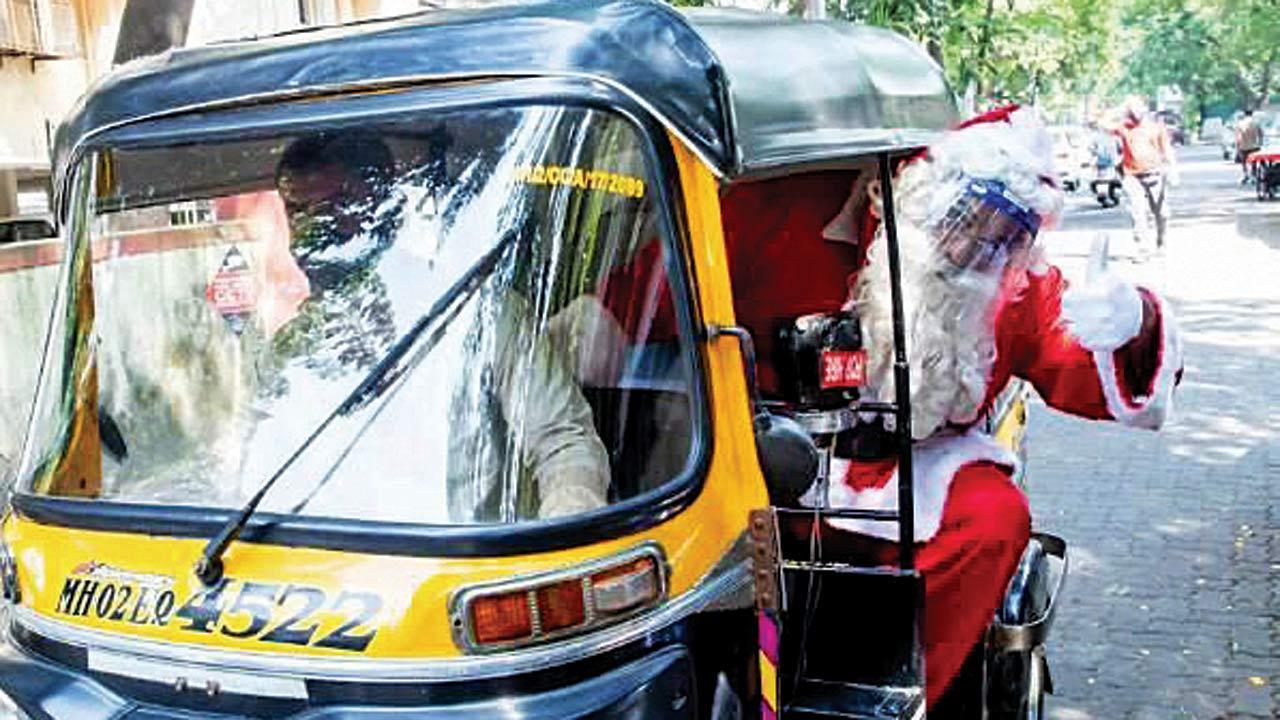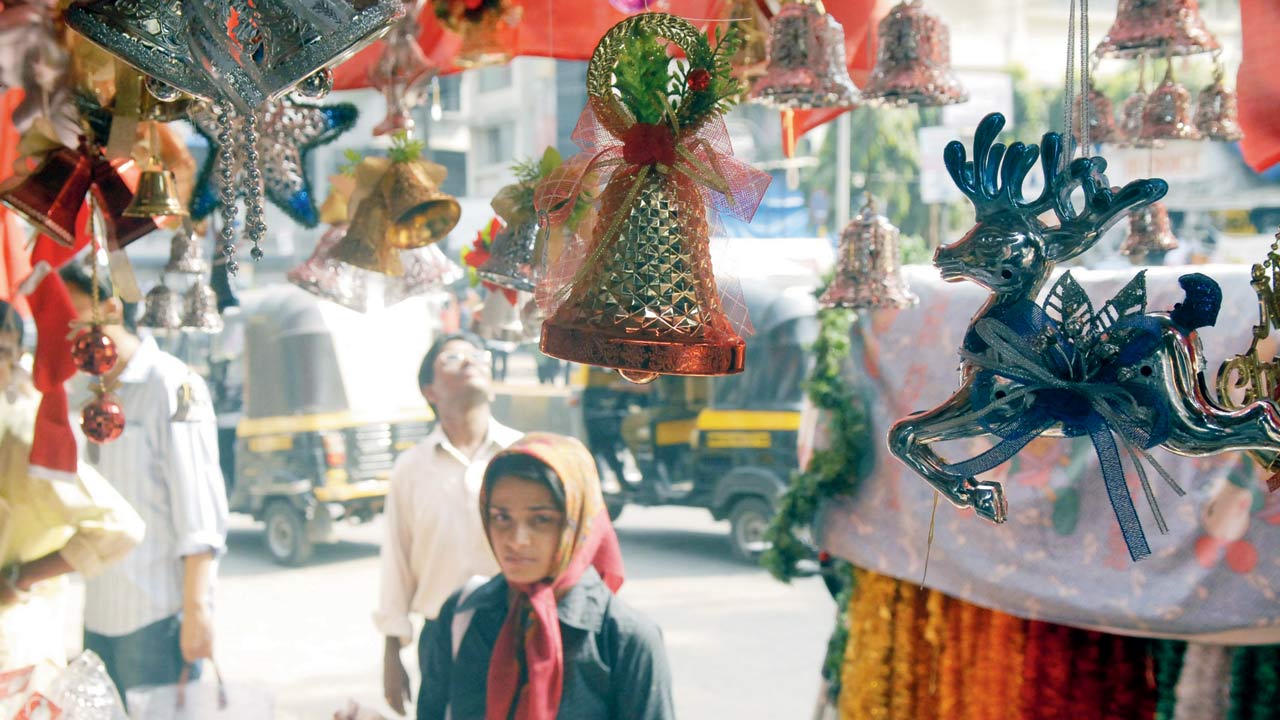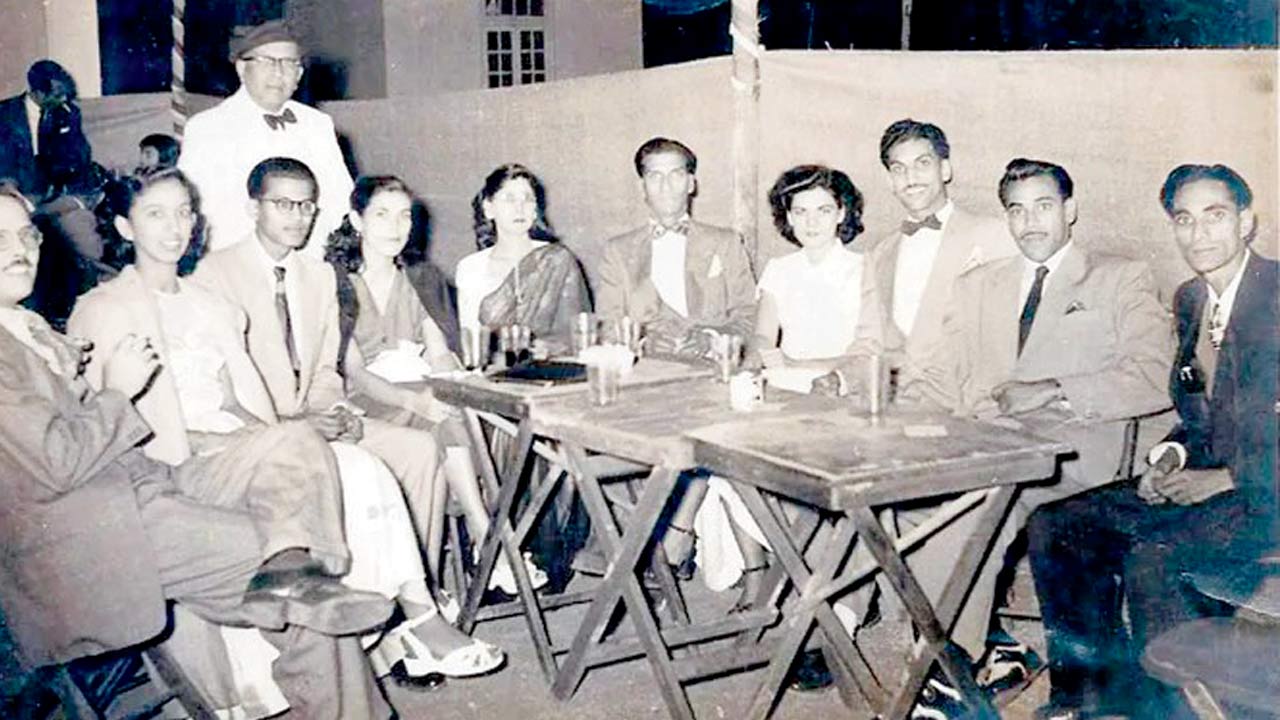A sampler of our favourite stories of the season unfolding across some Catholic bastions of Bombay

Santa hops a rickshaw ride for A Very Bandra Christmas. Pic Courtesy Neil Valles Photography
 A Bandra childhood is unforgettable for countless reasons. This time each year ranks way up on the list. I remain fully fascinated by the trappings of Xmas. Not just carols and cribs, tinsel and trees, but plump piles of sinful sugar plums, rum balls and milk creams that beckon invitingly. We received them from East Indian and Goan neighbours in holly-twigged trays trimmed with smiling, satin-shiny Santas.
A Bandra childhood is unforgettable for countless reasons. This time each year ranks way up on the list. I remain fully fascinated by the trappings of Xmas. Not just carols and cribs, tinsel and trees, but plump piles of sinful sugar plums, rum balls and milk creams that beckon invitingly. We received them from East Indian and Goan neighbours in holly-twigged trays trimmed with smiling, satin-shiny Santas.
Architect Clement DeSylva deconstructs these delectable treats in his book and blog, Bandra Buggers: “Marzipan had to be stirred clockwise, from the inside out, like a Well of Death rider. When it dripped on the stove side, our fingers transported it into our mouths, and us to Christmas sweet heaven. From 100 dates to deseed, 20 went missing in action. Caught with the date in a pretending-to-be-empty mouth, you got whacked with the belan!”
ADVERTISEMENT
 On December 25, 1718, St Thomas’ Cathedral at Fort welcomed an inaugural flock of the city’s faithful. File pic
On December 25, 1718, St Thomas’ Cathedral at Fort welcomed an inaugural flock of the city’s faithful. File pic
Bandra brims with the spirited buzz of community feeling. In 2001, residents of St Anthony’s Road revived the tradition of live carol singing down the street. With professional musicians performing, including Leslie Lewis, Xavier Fernandes and Jazzy Joe, the effort grew. Old-timers here and abroad eagerly marked calendars in anticipation of the Carols programme. “What began as a little road show went on in lockdown to be the online, ‘A Very Bandra Christmas’. Suddenly, the world became an extension of our road,” says Annabelle Ferro.
No slouch when it comes to either revelry or reflection, Byculla once matched Bandra, twinkle for twinkle, toot for toot. This midtown quarter is graced by the lovely lines of Neo Classical-designed Christ Church. Though opening in 1833, the church was mooted a few years earlier by Governor Monstuart Elphinstone. Shifting from Fort to his “country home” in Byculla-Parel, he had wanted Christ Church to save him the inconvenience of mass at distant St Thomas’ Cathedral.
In the middle of the Alexandra Terrace compound, where Clare Road abuts Victoria Road, Father Christmas sat centre-stage, all swagger in a sleek Plymouth convertible packed with presents, his ebullient Ho-ho-hos echoing wide. Byculla’s biggest Christmas star hung suspended between the second-floor levels of Lobo Mansion and Haroon Court in Christ Church Lane.
 Stars, tinsel and tree decorations sparkle down the length of Hill Road. File pic
Stars, tinsel and tree decorations sparkle down the length of Hill Road. File pic
Counters stacked tight with embroidery materials, lingerie, lace and ribbons (exposed rubber-bands looping schoolgirl ponytails were punishable by nuns of nearby convents), haberdashers like Amir Stores stocked Tootal ties, Coats thread, Wendy’s wool and purposefully picked white gloves. The shop downed shutters late at Xmas and New Year. After midnight mass, revellers dashed in last-minute for gloves donned to dances. And funerals—two undertakers, Frank Binks and Edward Jones, preceded John Pinto’s services here.
In an open plot behind Pinto’s funeral parlour, coffins lay rowed in various stages of preparation. Those ready with soft silk lining doubled as cosy beds for tipsy layabouts locked out of home on rough nights. The billiard table in the Byculla Railway Institute served as a harder bed when they were found too tipsy to handle.
Feet away, American Express Bakery still exudes flour power. With the tagline “We knead your needs”, the pink-walled heritage headquarters, AEB House, heralds a season of fresh dough delights. Supplying bread to US ships touching wartime Bombay harbour earned American Express its name. Fourth-generation owners Emil and Yvan Carvalho recall their great-great grandfather Francisco pioneer the enterprise in 1908 from a Falkland Road outlet. Emil says, “In a city that suffers floods and riots, we ensure individual requirements reach on time.”
 Gathering at St Anthony’s Pavilion, the “church, school and club” of 1940s Chembur. Pic courtesy Anette D’Cruz
Gathering at St Anthony’s Pavilion, the “church, school and club” of 1940s Chembur. Pic courtesy Anette D’Cruz
Further south, customers succumbed in restaurants like Gaylord, at Churchgate, to a tempting Xmas lunch of roast chicken with gravy, cranberry sauce, honey glazed ham and potato rosti, rounded off by traditional Christmas pudding with a rich rum flambe.
A Colaba resident remembers school in the 1950s gave Michaelmas holidays. September 29, Michaelmas Day, honouring the Archangel Michael, held the earliest hints of Christmas. Kids rolled rose cookies, coconut fudge and guava cheese, and patted flour flat on backs of forks, shaping kulkuls to fry. Morning mass was followed by a roast masala duck breakfast with the extended family, before the youngest were allowed to excitedly tear open gifts. The piece de resistance of the heavy midday repast was suckling pig, ringed by sorpotel, pork vindaloo, stuffed turkey and sliced ham. The excess was crowned by bibinca as dessert.
With several Byculla, Dhobi Talao and Colaba Catholics moving north, Christmas trees in the Malad gardens of Orlem tower four floors high, festooned for al fresco parties. Soon approaching is the February feast of one of the Virgin Mary’s 18 apparitions. The entrance to Our Lady of Lourdes Church displays the Mother of God visit 14-year-old shepherdess Bernadette Soubirous in the cave of Massabielle, near Lourdes, on February 11, 1858. Built as a private chapel in 1880 by Msgr Joseph Braz D’Souza, its flock soared from 12 families in huts in 1916 to 18,500 members.
Before Chembur was declared Parish of Our Lady of Perpetual Succour in 1954, St Anthony’s Pavilion was church, school and club. Anette D’Cruz remembers her grandfather’s annual ritual. “On December 24 he’d get out the kerosene lamp and clean the wick for Midnight Mass. At 11.30 pm, lamp lit, he led us single-file along narrow paths through fields where snakes and nocturnal creatures roamed.”
The flower-decked altar shone bright, polished and prettied the previous evening under the benign gaze of a cohort of saints. The sacristan, Herbert Cardoz ignited tall candles with a “magic stick”, both lighter and extinguisher. Prayers were chanted in beautiful Latin sonority and solemnity. While the choir trilled, trying to ignore jackals howling in the distant darkness.
At the other end of town, diving into Dickensian alleys of Dhobi Talao-Kalbadevi hamlets of Sonapur, Dabul and Cavel is always interesting. In Wellington Terrace, on the Sonapur street saluting physician-mayor Simon Fernandes, residents long for neighbours who have moved to Orlem and Borivli. A retired engineer says, “Colonies were populated enough for people to sleep on corridor landings. Till the ’70s this wadi hosted festive dances on a wooden floor.”
Our Lady of Dolours Church was a cemetery, then a chapel before attaining church status. At Kaizer Building opposite, Carey and Thomas D’Souza manage C D’Souza, the cafe-cum-confectionery famed for bibinca, bolinhas, dodol, doce, fruit tarts and plum cake. Their grandparents Caridade and Maria Ruzai introduced it in the 1950s. (Her name had prompted Marosa Restaurant in 1947 at Fort.)
Likening this precinct to the 1930s Bronx, Adriano Pinto drolly described how the Dolours priest placed a loudspeaker in C D’Souza’s to drown conversation during sermons. “That resulted in coffee-talk rising many decibels, disturbing the vicar himself… Women with sleeveless dresses, without head scarves, were publicly berated. Khomeini must have learnt his statecraft from Sonapur priests.”
Nearby, Claude D’costa, the Phantom Revival bassist, rocked jam sessions on the fretted verandahs of Cavel. This is where the Church of Our Lady of Health is flanked by Pope’s Town and Bishop’s Town compounds. Carol crooning done, post-Xmas brought jousting to jollity, rivalry to revelry. Fierce feuds at New Year’s Eve judged which compound stacked more hay boys of the hood stole from passing Victorias, to burn the ubiquitous “old man” effigy.
The campfire highlight was the parody of a song by Vaudeville and Broadway comedians Edward Gallagher and Al Shean. Every original stanza snapped close with a punchline by Gallagher, after which Shean sang “Absolutely, Mister Gallagher?” and Gallagher replied “Positively, Mister Shean!” Local talent Ernie Flanagan substituted topical verses to that tune, ribbing residents about their year’s goings-on.
Xmas could be hectically tough. Actor Keith Stevenson reminisces about his parents’ Kemp’s Corner salon. “We never celebrated Christmas-New Year like other people. Mum and dad worked incessantly. Raechelle Beauty Parlour opened at 7 am. By the time the last clients were attended to, they could almost see Santa riding his sleigh in the sky. When they got home, both were too beat to celebrate, but loved every moment.”
Bombayites dreaming of a White Christmas looked forward to handwritten epistles in unwired decades. Another DeSylva blogpost notes: “In faraway Mississauga they wait for Christmas snow. In Bandra we waited for the first Christmas card. There were specially issued Papal postal seals. Foreign stamps steamed off envelopes went into albums. Cards were strung spanning doorways or placed upright on the piano. Cows, donkeys and Baby Jesus in 3D cards from Japan were as real as real could be. Then came the global web. The postman’s bags get lighter every year. The telegram wallah has thrown in the towel. And Gentleman Jim is going to be singing ‘There’s an old Christmas e-mail’.”
Author-publisher Meher Marfatia writes fortnightly on everything that makes her love Mumbai and adore Bombay. You can reach her at meher.marfatia@mid-day.com/www.mehermarfatia.com
 Subscribe today by clicking the link and stay updated with the latest news!" Click here!
Subscribe today by clicking the link and stay updated with the latest news!" Click here!








